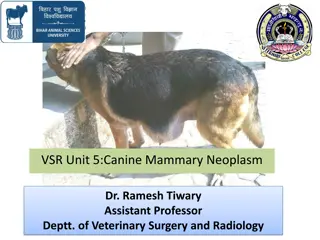
Infrastructure Delivery Management System (IDMS) and Integration Strategies
Explore the purpose and implementation of the Infrastructure Delivery Management System (IDMS) for integrated infrastructure planning and delivery. Learn about asset management, portfolio implementation, procurement strategies, and more to enhance socio-economic growth effectively and efficiently.
Download Presentation

Please find below an Image/Link to download the presentation.
The content on the website is provided AS IS for your information and personal use only. It may not be sold, licensed, or shared on other websites without obtaining consent from the author. If you encounter any issues during the download, it is possible that the publisher has removed the file from their server.
You are allowed to download the files provided on this website for personal or commercial use, subject to the condition that they are used lawfully. All files are the property of their respective owners.
The content on the website is provided AS IS for your information and personal use only. It may not be sold, licensed, or shared on other websites without obtaining consent from the author.
E N D
Presentation Transcript
INFRASTRUCTURE MTEC PRESENTATION 02-04 SEPTEMBER 2015 1
PRESENTATION OUTLINE 1. PURPOSE 2. INFRASTRUCTURE DELIVERY MANAGEMENT SYSTEM (IDMS) 3. IDP / WARD BASED PLANNING APPROACH 4. INTEGRATION OF PROVINCIAL AND LOCAL SPHERE 5. 2016/17 MTEF BIDDING PROCESS 6. EXPECTATIONS 2
PURPOSE To ensure that there is integration, coherence and consolidation of the infrastructure plans as infrastructure is the catalyst on improving the socio-economic growth of the Province. To ensure that delivery is taking place and value for money is achieved as well as building the state for continuity thereby ensuring the sustainability and the achievement of objective in an efficiency, effectiveness and economic manner. The alignment of the Integrated Development Plans (IDPs) with the IDMS (alignment of infrastructure in the provincial and local spheres) which can achieve integration. The Infrastructure MTEC should thus include 2 main themes, namely the integration of infrastructure programmes; and the bidding, implementation and performance of the infrastructure programmes. The resolutions of the Infrastructure MTEC should inform the policy direction of the province and the deliberations of the broader MTECs. 3
INFRASTRUCTURE DELIVERY MANAGEMENT SYSTEM (IDMS) Infrastructure Delivery Management Processes and Control Framework Asset Management Strategy for portfolio implementation Review Delivery Management Strategy Review Infrastructure Procurement Strategy Review Portfolio Management Requirements DP1: Portfolio Planning Asset Asset Service Life Planning Management Planning (10yrs) CP Programme Planning and Budgeting Programme Implementation Review Programme Management Plan Review Current Commitments Project Prioritisation & Budgeting (3yrs) Strategic Brief Preparation Monitoring, Control and Reporting Quarterly Performance Evaluation DP2: CP CP Programme and Project Management Pre- Upload Data on Financial System Administrative Closure Design Development Financial Closure Feasibility Study Detail Design Strategic Briefing Works completion Business Case Feasibility Study Works Inception Stage Planning Stage Close-out Stage Design Stage Works Stage CP CP CP CP CP Existing Framework Agreements Solicit Tender Offers Evaluate Tender Offers Award Contract Administer Contract Procurement Process or Stage Accept Issue task batch, package order Prepare procure- ment documents Verification of Responsive- ness Verify Compliance with Contract Conditions Request for Tenders Issue task batch, package order Conclude contract Contract Closure Budget Confirmation Evaluation Adjudication CP CP CP CP CP 4
IDP / WARD BASED IDP / WARD BASED PLANNING APPROACH PLANNING APPROACH 2015/06/04 5
PHASE 0: Preparations and Programme for Ward Based Planning (WBP) Council & Management briefing Publication of Ward Capacitate stakeholders Engagement to ensure community participation PHASE 1: Ward Analysis and Processes to Identify and Determine Ward Needs Desk Top Situational Analysis informed by the following: Study Area ward specific; Demographic Trend; Socio-economic Dimension; Service Delivery and Infrastructure Development Dimensions; Community Services 1st Community Consultation & application of tools: Timeline, Seasonal & Venn diagram, Spatial Dimensions: Mapping, Spatial SWOT Analysis, Livelihood Analysis (Sector Participation critical) IDP Rep Forum to present Situational Analysis inclusive of WBP issues
PHASE 2: Development of Strategic Objectives 2nd Community Engagement Confirmation of ward priorities, Ward Vision; Ward Strategic Objectives; PHASE 3: Municipal 5-year Project Selection and Evaluation - Comprehensive Infrastructure Project (CIP); 3 Yr. Capital Plan & Comprehensive Project Implementation Plan (CIDP) Steering Committee (incl. Sector Departments & technical team) Development of a 5Yr CIP, Sector Plans alignment, 3- year Capital Plan & CIDP
PHASE 4: Integration of projects & programmes IDP Representative Forum Meeting to comment on Consolidation contained in Draft IDP( inclusive of 3 Yr. Capital Plan & CIDP), Draft 5-year CIP PHASE 5: Adoption (Draft and Final) Adoption of Draft 5 Year IDP & CIP
INTEGRATION OF PROVINCIAL AND LOCAL SPHERE (GATE 0) Gate 0 is the project inception and a report is prepared and approved by the delegated officials. Objective decision making criteria are based on factors such as alignment of strategic level components( sector policy imperatives, e.g. norms and standards driven by curriculum mix, the E-Learning and deliverables identified in the APPs) across all spheres of government, the level of stakeholder support, the legislative compliance, the risk considerations and financial justification shall be used to motivate the acceptance of a project. There is thus a great need to ensure that planning commences two years in advance. Project Initiated Ward Based Planning as defined in IDP guide (Public participation) From existing asset base as guided by norms. IDP representation forum which recommends projects Business Brief (Gate 0/1) Motivation for project / package Needs assessment Alignment with service level standards and norms Departmental Approval / Council Resolution 9
INFRASTRUCTURE BIDDING PROCESS The components of the assessment process includes: Performance information weighting of 30 per cent -Year-end evaluation as per Section 13(2)(c) of DORA (completed on 29 May 2015) -IRM Section 11(4)(c) ( done on quarterly basis but updated monthly) The Human Resources (HR) capacitation weighting of 20 per cent -HR DoRA S 2(b) which requires critical skills in infrastructure units( done on quarterly basis but EC still non compliant) Planning and technical information weighting of 50 per cent - User Asset Management Plans (UAMPs) Section (27)(4) (submitted on 25 June 2015) - Infrastructure Performance Management Plans (IPMPs) and the Construction Procurement Strategy (due on the 18 September 2015) - Project proposal (prefeasibility and concept reports) (due on the 18 September 2015) - There is also a compulsory requirement for provincial infrastructure MTEC hearings (2- 4 September 2015) 11
Thank you 12






















